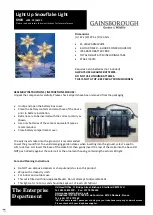
8
3.0 INSTALLATION
3.1 OVERVIEW:
Full body harnesses are to be used as part of a Fall Protection system. Ensure each component of your Fall
Protection system is installed per the manufacturer instructions.
3.2 PLANNING:
Plan your Fall Protection system before installation. Account for all factors that may affect your safety
before, during, and after a fall. Consider all requirements and limitations specified in these instructions.
A. ANCHORAGE:
Select an anchorage capable of sustaining the static load requirements of the intended Fall Protection
application. See the manufacturer instructions for each component of your Fall Protection system for more information.
The anchorage location should address all requirements specified in these instructions.
B. SHARP EDGES:
Avoid working where system components may be in contact with, or scrape against, unprotected
sharp edges and abrasive surfaces. All sharp edges and abrasive surfaces should be covered with protective material.
C. CONNECTING SUBSYSTEMS:
Connecting subsystems used with the harness must be suitable for your system
application. See the Product Overview and Figure 2 for more information, as well as the manufacturer instructions for
your connecting subsystem.
D. HARNESS STRETCH:
Some amount of harness stretch should be expected when using this product as part of a
Fall Arrest system during fall arrest. See “Table 1 – Product Specifications” for how much harness stretch should
be expected when using this product. Harness stretch should be added to all fall clearance requirements for your
system, unless it is already accounted for by the connecting subsystem or another component. See the manufacturer
instructions of your connecting subsystem for more information on fall clearance requirements.
;
Maximum harness stretch is determined by the applicable standard or regulation.
3.3
BEFORE INSTALL:
Before donning your harness, you should do the following.
•
Inspect the harness per the “Inspection and Maintenance Log”.
• Disconnect all buckles.
• Straighten all harness straps so that none are twisted.
• Empty your pockets. Items left in pockets may prevent your harness from properly securing or cause injury in the
event of a fall.
3.4
DONNING THE HARNESS:
Donning a full body harness is a procedure with multiple steps. Each step should be followed
carefully. Different styles of harnesses may include different sets of features, resulting in different steps for donning. See
Figure 6 for reference. See Figure 1 to identify your harness style.
A. VEST-STYLE HARNESSES:
“Vest style” harnesses include two torso straps and a chest buckle. See Figure 6A for
reference.
1. Put on the harness.
Lift the harness by its dorsal D-ring. Slip on the torso straps, then let the harness hang
loosely from your shoulders. Position the chest buckle on your chest as shown. Verify no straps are twisted.
2. Connect the harness buckles.
Secure the leg straps first, then secure the chest buckle. If present, secure the
waist belt buckle.
;
See Section 3.6 for buckle instructions.
See Figure 1 for which buckles are on your harness.
3.
Adjust the harness for proper fit.
Check all adjustable features on your harness, including buckles and
adjusters. Position the sub-pelvic strap and adjust your leg straps, then adjust your torso straps. All harness
straps should have a snug, comfortable fit.
;
See Section 3.7 for adjuster instructions.
See Figure 1 for which adjusters are on your harness.
Figure 6A - Donning the Vest-Style Harness
3.5
EQUIPMENT CHECK:
Use these equipment checks to verify that your harness is properly installed. See Figure 7 for
reference.
;
The user should verify with a second trained user that their harness has been properly installed.
A. All buckles and adjusters are secure.
Check each harness strap to verify that all buckles are connected, and that
each adjuster is locked in place.
B. All harness straps are comfortably snug.
Check the fit of your harness straps. Ensure no harness straps are
1
2
3






































